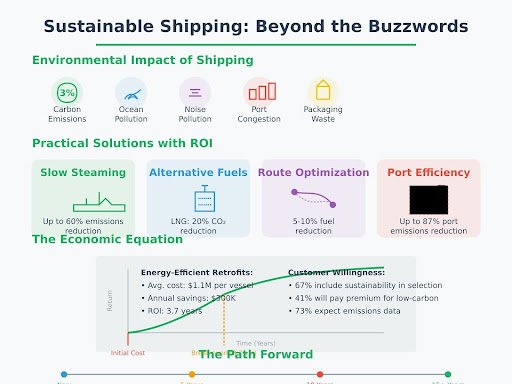In an era where “sustainability” adorns nearly every corporate website and annual report, the shipping and logistics industry faces a particularly complex challenge. Moving goods across oceans and continents inherently generates significant environmental impacts—yet global commerce depends on this movement. How can shipping companies move beyond superficial green initiatives to create meaningful change while maintaining economic viability?
The True Environmental Cost of Global Shipping
Before discussing solutions, we must understand the scope of the problem. The shipping industry’s environmental footprint includes:
- Carbon emissions: Maritime shipping alone accounts for approximately 3% of global greenhouse gas emissions—comparable to major industrial nations.
- Ocean pollution: From ballast water exchanges to fuel spills, shipping activities directly impact marine ecosystems.
- Noise pollution: Underwater shipping noise disrupts marine life communication and navigation.
- Port congestion: Idling vessels and vehicles at overloaded ports create concentrated pollution hotspots.
- Packaging waste: The movement of goods generates billions of tons of packaging in e-commerce international shipping materials annually.
“When we talk about sustainable shipping, we need to consider the entire ecosystem of impacts, not just carbon,” explains Dr. Elena Rodrigues, marine ecologist and sustainability consultant. “The most effective strategies address multiple environmental challenges simultaneously.”
Practical Approaches with Proven ROI
While perfect solutions remain elusive, companies across the shipping spectrum are implementing practical approaches that deliver both environmental and economic benefits.
Slow Steaming: Simple Yet Effective
One of the simplest and most immediately impactful changes involves reducing vessel speeds—known as “slow steaming.” A container ship that slows from 24 to 18 knots can reduce fuel consumption and emissions by up to 60% while extending engine life.
Mediterranean Shipping Company implemented slow steaming across its fleet in 2009 and has since reported:
- 30% reduction in fleet-wide carbon emissions
- 15% reduction in maintenance costs
- Improved schedule reliability despite slower travel times
The trade-off? Longer transit times—though many shippers have adapted their planning horizons accordingly.
Alternative Fuels: Beyond Experimentation
While zero-emission vessels remain on the horizon, transitional fuel solutions are already delivering results:
Liquefied Natural Gas (LNG) CMA CGM’s LNG-powered vessels have demonstrated:
- 20% reduction in carbon dioxide emissions
- 99% reduction in sulfur emissions
- 85% reduction in nitrogen oxide emissions
- Comparable operational costs after initial conversion investment
Biofuels Maersk’s biofuel pilots using cooking oil-derived fuels have shown:
- Up to a 85% reduction in well-to-wake carbon emissions
- Drop-in capability requiring no engine modifications
- Cost premium of approximately 10-15% over conventional fuels
Route Optimization Meets Weather Routing
Advanced algorithms now help vessels navigate around adverse weather while minimizing fuel consumption. The Swedish company StormGeo helps shipping companies optimize routes based on real-time ocean and weather data, resulting in:
- 5-10% reduction in fuel consumption
- Improved safety metrics
- Increased schedule reliability
“The beauty of weather routing is that it simultaneously improves environmental performance, safety, and operational efficiency—a true win-win-win,” notes Captain James Wilson, a 30-year maritime veteran now working as a shipping consultant.
Port Efficiency: The Often Overlooked Factor
While much attention focuses on vessels, significant pollution occurs when ships idle at congested ports. The Port of Los Angeles has implemented several efficiency measures including:
- Shore power connections (cold ironing) allowing ships to turn off engines while docked
- Automated appointment systems reducing truck idling time by 40%
- Real-time data sharing between stakeholders reducing vessel waiting times
These initiatives have collectively reduced port-related emissions by 87% for diesel particulate matter and 58% for nitrogen oxides since 2005.
The Economic Equation: When Green Makes Financial Sense
The most successful sustainability initiatives in shipping share a common feature: they deliver tangible financial benefits alongside environmental improvements.
Initial Cost vs. Lifetime Value
While many green technologies require higher upfront investment, their total cost of ownership often proves favorable:
Energy-Efficient Retrofits A study of 400 vessels that underwent energy efficiency retrofits found:
- Average implementation cost: $1.1 million per vessel
- Average annual fuel savings: $300,000 per vessel
- Return on investment: 3.7 years
- Additional benefits: Compliance with emerging regulations, improved corporate reputation
The Carbon Price Factor
As carbon pricing mechanisms expand globally, previously marginal efficiency improvements become increasingly valuable:
“Five years ago, a 5% fuel reduction might not have justified certain investments,” explains Maria Chen, Sustainability Director at a global logistics firm. “Today, with carbon taxes in many markets and fuel prices continuing to rise, that same 5% improvement can transform the business case.”
Customer Willingness to Pay: Market Reality Check
Perhaps the most significant shift in the sustainable shipping equation is customer sentiment. A 2023 survey of global shippers found:
- 67% now include sustainability metrics in carrier selection criteria
- 41% are willing to pay a premium for verified low-carbon shipping options
- 73% expect detailed emissions data for their supply chains
“We’ve seen a fundamental shift in customer expectations,” notes Thomas Rodriguez, VP of Global Logistics for a multinational retailer. “Five years ago, sustainability was a nice-to-have feature. Today, it’s table stakes for maintaining business relationships with major brands.”
From Individual Actions to Industry Transformation
While company-level initiatives yield important benefits, truly sustainable shipping requires industry-wide transformation. Several collaborative efforts show promise:
The Sea Cargo Charter
This framework establishes a common methodology for assessing and disclosing shipping emissions, creating transparency and accountability across the maritime supply chain. Over 30 major companies have signed on, representing approximately 15% of global seaborne trade.
Zero-Emission Vessel Initiatives
Coalitions like the Getting to Zero Coalition bring together companies across the maritime value chain to develop commercially viable zero-emission vessels for deployment by 2030. These collaborative efforts help share development costs and risks while accelerating innovation.
The Path Forward: From Incremental to Transformational
The shipping industry’s sustainability journey requires both immediate practical steps and longer-term transformation:
Near-term priorities (0-5 years):
- Widespread implementation of proven efficiency measures
- Alternative fuel adoption where economically viable
- Data standardization for emissions tracking and reporting
- Investment in port modernization and efficiency
Mid-term horizon (5-10 years):
- First commercial zero-emission vessels for short sea shipping
- Mature carbon markets with reliable pricing mechanisms
- Regulatory frameworks that reward sustainability leaders
- Integration of emissions data throughout supply chains
Long-term vision (10+ years):
- Fleet-wide transition to zero-emission vessels
- Circular economy principles applied to shipping materials and equipment
- Fully transparent emissions tracking across global supply chains
Beyond Environmental: The Social Dimension of Sustainability
True sustainability encompasses social impacts alongside environmental concerns. Leading shipping companies are addressing:
- Crew welfare: Including mental health support, fair wages, and reasonable working hours
- Community impacts: Reducing pollution and noise near ports and shipping lanes
- Safety standards: Implementing processes that protect both workers and the environment
“Environmental improvements that come at the expense of human wellbeing aren’t truly sustainable,” emphasizes Dr. Sarah Johnson, maritime labor specialist. “The most effective programs consider both dimensions together.”
Conclusion: Substance Over Symbolism
As the shipping industry navigates its sustainability journey, the distinction between substantive action and symbolic gestures grows increasingly clear. Companies that approach sustainability as core business strategy rather than peripheral activity are discovering competitive advantages alongside environmental benefits.
The path forward requires honesty about trade-offs, willingness to invest in promising technologies, and commitment to continuous improvement rather than perfect solutions. Most importantly, it demands transparency—sharing both successes and challenges as the industry works toward truly sustainable global commerce.
The era of sustainability as mere buzzwords is ending. In its place emerges a more sophisticated approach that recognizes environmental responsibility as essential to long-term business viability in an industry that literally connects our world.





